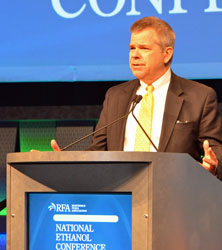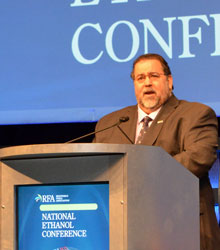 Growth Energy and environmental groups are adding their voices of comments to California’s proposal to its clean air regulations. In a news release, Growth says the California Air Resources Board’s (CARB) proposed amendments to the state’s Low Carbon Fuels Standard (LCFS) Regulation and the Proposed Regulation on the Commercialization of Alternative Diesel Fuels are unnecessary under the state’s environmental mandates.
Growth Energy and environmental groups are adding their voices of comments to California’s proposal to its clean air regulations. In a news release, Growth says the California Air Resources Board’s (CARB) proposed amendments to the state’s Low Carbon Fuels Standard (LCFS) Regulation and the Proposed Regulation on the Commercialization of Alternative Diesel Fuels are unnecessary under the state’s environmental mandates.
David Bearden, General Counsel of Growth Energy noted, “If adopted, the current LCFS proposal will have a devastating impact on Growth Energy’s members, who will be forced to exit from the California alternative fuels market. Such an outcome will likely trigger the cost-containment caps in the proposed regulation, and any claimed benefits of the LCFS program will be compromised or lost.”
Specifically, the comments noted:
The LCFS regulation is no longer needed to achieve the greenhouse gas reductions sought in the 2009 LCFS regulation. Since the Board first adopted the LCFS regulation in 2009, much has changed in efforts by the state and federal government to reduce greenhouse gas (“GHG”) emissions from motor vehicles. Growth Energy presented a proposed alternative to the LCFS regulation to CARB staff in June 2014 that would simply adjust California’s cap-and-trade regulation to account for any incremental GHG emission reductions forgone by eliminating the LCFS. Following review of Growth Energy’s proposal, the CARB staff agreed with Growth Energy that Growth Energy’s proposal would likely achieve the same level of GHG emissions reductions as the 2009 LCFS regulation through 2020. Growth Energy’s proposal had none of the unintended negative environmental consequences of the 2009 LCFS regulation, which have been the subject of litigation, and would have eliminated the need for California businesses and consumers to pay for the LCFS program ─ costs that the CARB staff now says may range up to about 12 cents per gallon by 2020.
Growth added that the new justification for the LCFS regulation ignores the federal renewable fuels program, and CARB is not properly accounting for the beneficial effects of the federal renewable fuels standards.
Those sentiments are echoed by the Energy Future Coalition (EFC) and Urban Air Initiative (UAI), which are urging CARB to bring ethanol into the mix.
“Simply replacing gasoline, which is increasingly carbon intensive, with ethanol provides substantial carbon reductions. Using that ethanol to replace toxic compounds used for octane provides a dual benefit of protecting public health,” said David VanderGriend, President of UAI.
“Our research has shown that there is a clear linkage to gasoline and a range of negative health effects. So reducing carbon isn’t just a matter of greenhouse gas and potential climate change but also saving lives by reducing toxic emissions.”
 Last year at the National Ethanol Conference, EPA’s Director of the Office of Transportation and Air Quality told the ethanol industry that the agency intended to finalize the volume requirements for the Renewable Fuel Standard (RFS) by the end of spring 2014.
Last year at the National Ethanol Conference, EPA’s Director of the Office of Transportation and Air Quality told the ethanol industry that the agency intended to finalize the volume requirements for the Renewable Fuel Standard (RFS) by the end of spring 2014.








